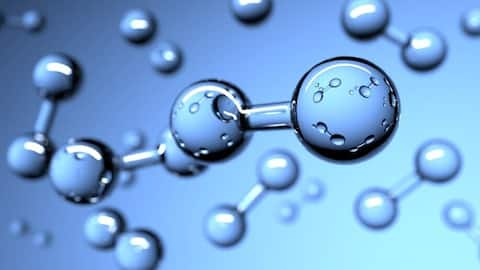Scientists produce hydrogen fuel using aluminum cans, seawater, and caffeine
What's the story
Researchers at the Massachusetts Institute of Technology (MIT) have developed a unique method to make hydrogen fuel using recycled soda cans, caffeine, and seawater.
The study, published in Cell Reports Physical Science, reveals that pure aluminum from old soda cans can react with seawater to generate hydrogen gas.
"This discovery opens up a new pathway for sustainable hydrogen production," said Aly Kombargi, a PhD student in MIT's Department of Mechanical Engineering, and the lead author of the study.
Speed boost
Caffeine accelerates production process
The MIT researchers discovered that adding caffeine, mainly its active ingredient imidazole, significantly speeds up the reaction between aluminum and seawater.
This addition reduces the hydrogen production time from two hours to just five minutes.
"It was quite a surprise to find that caffeine could enhance the reaction so dramatically," Kombargi remarked.
The team is now developing a small reactor for maritime applications, that can be installed on marine vessels or underwater vehicles.
Marine power
On-demand hydrogen for maritime applications
The MIT team's reactor design allows marine vessels to produce hydrogen on demand by adding seawater to a mix of aluminum pellets, gallium-indium alloy, and caffeine.
"Vessels don't need to carry large amounts of water or hydrogen. They can simply use the seawater they travel through and the aluminum fuel they carry," Kombargi explained.
This method addresses significant challenges in hydrogen storage and transport by producing it on-site, eliminating issues related to leakage due to hydrogen's tiny molecules.
Reaction process
Aluminum's reactivity is the key
The process relies on aluminum's strong reactivity with oxygen.
When submerged in water, aluminum rapidly strips oxygen from H2O, releasing hydrogen gas.
However, the challenge of aluminum oxide buildup, which typically halts the reaction, is mitigated by pretreatment with gallium and indium.
"The pretreatment with gallium and indium is crucial," said Niko Tsakiris, a co-researcher on the project. "It keeps the aluminum reactive and prolongs the hydrogen production process."
Sustainable solution
Rare metals reusable, making process cost-effective
Despite the high cost and rarity of gallium and indium, the researchers found that the reaction in seawater allows the alloy to clump together and be easily recovered for reuse.
"This makes the process more sustainable and cost-effective," Kombargi noted.
The team is exploring other applications for this technology beyond marine use, including trains, trucks, and potentially even airplanes.
They are also considering extracting water from ambient humidity to produce hydrogen, further enhancing the system's versatility.
Future prospects
MIT researchers excited about technology's potential
The researchers are optimistic about the potential of this new technology to transform several industries and contribute to a cleaner, more sustainable future. "This is just the beginning," Kombargi stated.
In their experiments, a single pellet of aluminum, weighing just 0.3gm, produced 400 milliliters of hydrogen in five minutes when placed in fresh, de-ionized water.
The team estimates that one gram of aluminum pellets could generate 1.3-liter of hydrogen in the same timeframe.
